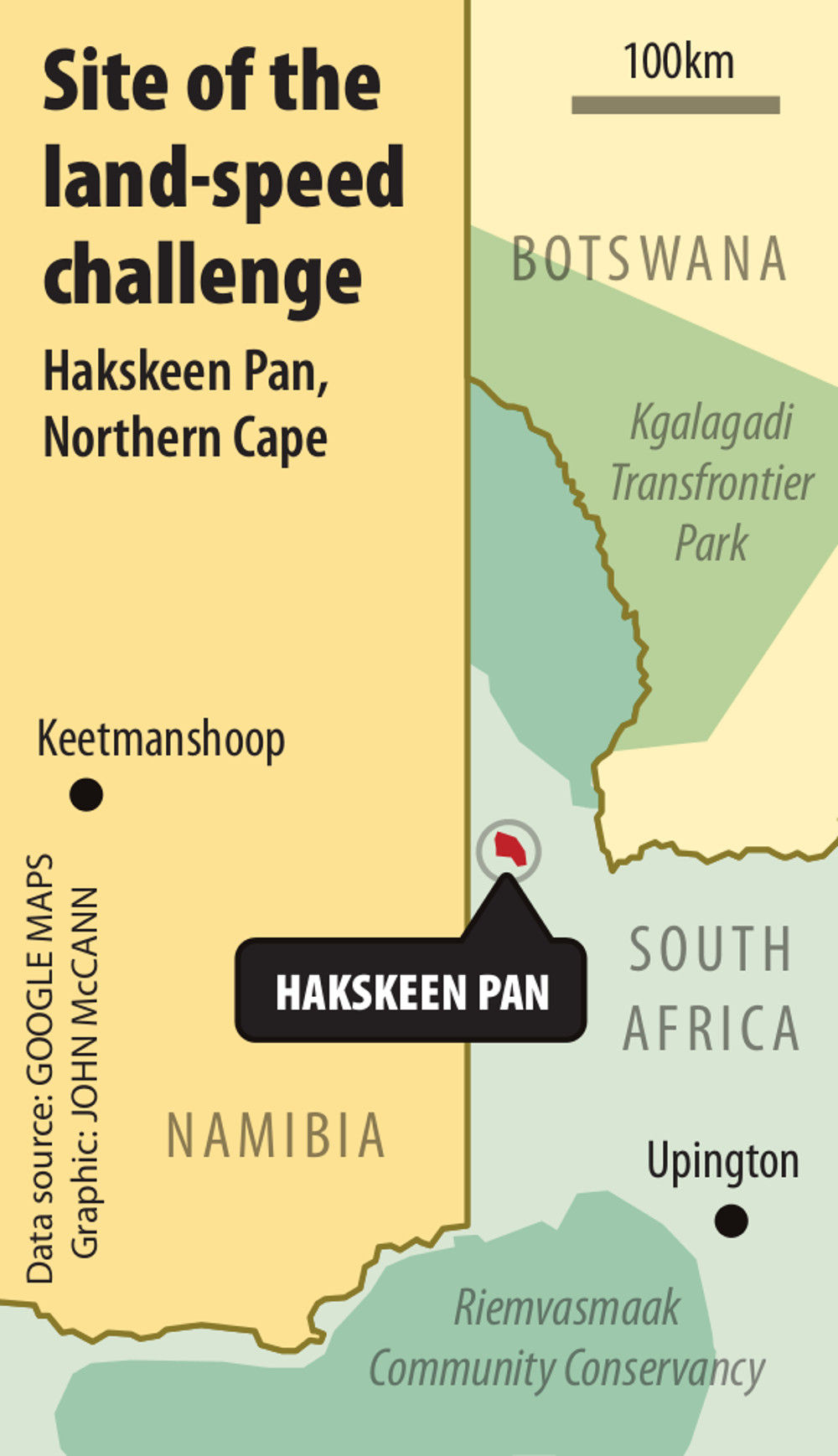Blink and you'll miss it: Andy Green will attempt to break the land-speed record in the supersonic Bloodhound.
Steven Morris Wing Commander Andy Green, Royal Air Force fighter pilot, record breaker and action hero, slipped off his shoes before clambering into the cockpit of the Bloodhound Supersonic Car, which is being handcrafted in Britain to hit the 609.34km/h (1 000 miles an hour) mark.
“I don’t want to put my boot through any of the digital displays,” he said. “That wouldn’t be too clever.”
By next year Bloodhound SSC will be racing along a Cornish test track and a few weeks later it will be transported to the desert area of Hakskeen Pan – situated in the middle of the Northern Cape finger that pokes up between Namibia and Botswana – where the plan is for it to reach 1 287.47km/h and break Green’s own current land-speed record of 1 227.93km/h. If all goes well, Green will return to South Africa and drive Bloodhound at 1 609.34km/h – faster than a bullet, faster than a commercial jet.
At the unveiling last week of the cockpit, a key stage in the development of the 10-year project, Green said the idea was not just to make history but to push back the laws of physics and inspire a new generation to become scientists and engineers. “This is the greatest engineering adventure in motor sport.”
Mission control for the Bloodhound challenge is an ordinary-looking unit on an industrial estate in Avonmouth near Bristol. On one side of Bloodhound HQ is a joinery, on the other a plumber’s merchants. In front is a greasy spoon burger van. But inside it looks like something out of a James Bond film.
Hard to grasp
It is hard to grasp just how fast 1 609.34km/h is. Green said the best way of illustrating it was to imagine it travelling the length of a football pitch. If a spectator blinked, he or she would not see the car driving past. “That is fast.”
The cockpit turns out to be a pleasing combination of the super-high tech and the ordinary. It features state-of-the art ballistic armour to protect the driver from a shooting stone or bird strike. But the triggers on the steering wheel that control the car’s rockets were taken from an ordinary hand power drill – because they are built to withstand huge vibration and dust. “They told me to go down to B&Q [a British DIY retailer] and pick the one I liked best,” said Green.

Should the digital displays suffer a catastrophic failure, the team got luxury watchmaker Rolex to create a comforting-looking analogue stopwatch and speedometer.
There are also chunky back-up levers to activate the parachutes that help to stop the car and cut off the fuel supply to the jet engine.
But, to be fair, most of it is super-high tech. The cockpit is made of five different types of carbon fibre weave and two different resins. Sandwiched between the layers of carbon fibre are three different thicknesses of aluminium honeycomb core to provide additional strength.
Shock waves
The roof of the cockpit and the front of the car have been designed to create a series of shock waves that will slow the air down and channel it into the Eurojet engine (airflow of 1 609.34km/h would damage the engine). That process – combined with the noise of the jet plus a racing car engine and a cluster of rockets – makes the cockpit a noisy place, at least until it outruns its sound waves.
Inside, the central control screen shows the speed in miles per hour and Mach number. The panel has also been designed to allow Green to keep a careful eye on the wheel loads – the key safety requirement is to keep the car’s wheels firmly on the ground. If they lift, Green will have a big problem.
Naturally, huge care has been invested in the titanium steering wheel, shaped to Green’s hands and finger reach. Buttons on the front control the radio (for communicating with his team rather than listening to music), air brakes and parachutes, and those power drill triggers on the rear of the handgrips prime and fire the rockets. Bloodhound has pedals like a normal car – right for the accelerator, left for the brakes, though the brakes only contribute to about 1% of the braking power.
For the moment the cockpit has a comfy foam seat. By next year this will be replaced by a carbon fibre one moulded to Green’s body shape to mitigate the effects of the huge G-forces that will be exerted on him.
Green said it would be noisy and hot (there is no air conditioning). Though he is the current land-speed record holder, having set the record in Thrust SSC in 1997, he accepts he does not know what it will be like to travel at 1 609.34km/h.
“This is human adventure, it’s about people doing stuff, it’s climbing Everest, it’s Neil Armstrong stepping on to the moon. We don’t know what it will be like in this cockpit. That’s part of the adventure.” – © Guardian News & Media 2014